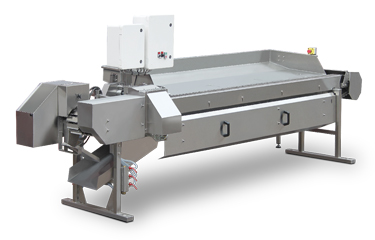Hygiene is an increasingly important factor in the seafood processing sector, according to Ulf Groenqvist, the owner and CEO of Färjestaden, Sweden-based seafood processing equipment-maker SEAC AB, which specializes in machines processing small fish. Its machines are capable of processing 70 to 100 fish per kilogram at a speed of more than 300 fish per minute.
In response to rising demand, especially from Asia, SEAC AB has redeveloped and redesigned its existing filleting machines to clean worms and parasites inside the belly cavities of fish. After two years of tests in China, Russia, and Sweden, the firm is now selling a new belly-cleaning line of filleting machines, given the name BC Lines by the company. The devices in the line can be integrated into two of the company’s filleting machines – the SEAC FPM-400 for smaller fish and SEAC FPM-470 for bigger fish.
Groenqvist sees Asia is a key market for SEAC, he said in an interview with SeafoodSource. The firm has supplied 40 SEAC FPM-200 H&G+T machines to the Philippines over the past five years.
SeafoodSource: Where have the new belly-cleaning machines been delivered?
Groenqvist: The first two complete automatic BC Lines have been delivered to two factories of a major canner in Vietnam. Unfortunately, due to the COVID-19 situation, the lines have not yet been installed, but hopefully they will be during September to November 2020.
Today, there are quite a few manufacturers of heading and gutting and tailing machines [H&G+T] machines in the world, but there are very few manufacturers of fish-filleting machines. SEAC AB is probably the world leader in processing machines for smaller and very small fish. We supply processors of smaller species like sardines, mackerel, and yellow croaker. During 2019, SEAC broke a world record in smallness when we filleted and belly-cleaned a six-gram fish in our workshop in Sweden.
SeafoodSource: Do you expect the coronavirus crisis to put a crimp in the seafood industry’s ability to invest in new machines?
Groenqvist: Of course, the post-COVID-19 environment will make things more difficult, but as one of our BC Lines filleting machine replace up to 40 operators, there are big advantages with them for the future. Besides, injuries in the fish-filleting industry are very common, so there is also a health and work environment improvement with our machines. But still, after 28 years in the business, we have notice that after "downs" in the world, fish processing machines are always needed, as seafood is cheap, healthy, and still easily [available].
SeafoodSource: Why have you focused on a new belly-cleaning capacity in your machines?
Groenqvist: Yield and capacity have for decades been the most important [factors] in this field of processing pelagic fish, but [in] recent years, something else has been arising on the market – how to get rid of the parasites and worms sitting inside the belly cavity, the belly-flaps, or elsewhere inside the fish. In horse mackerel or scad, the small bone growing close to the anus has been a problem for years during processing. In more than 10 percent of the processed fish, the entrails have been found growing around this bone, meaning the fish is not 100 percent cleaned.
SeafoodSource: How does the belly-cleaning system work?
Groenqvist: There are two possible ways to do the belly-cleaning. The machines in Vietnam [which process mackerel and sardine] use one knife when opening the belly via a longitudinal cut and then use the same or similar technique during the operation. This is the brand-new system. An alternative system uses two horizontal belly-cutting knives when opening the fish belly with the cleaning process inside the belly cavity done via brushes, EV stones, and water. You cannot use both alternatives in the same standard machine, [thus] it is necessary to judge best processing system for you.
SeafoodSource: Why has the issue of the parasites and worms sitting inside the belly cavity of the fish become an issue in recent years? Is that because there are more of them than before?
Groenqvist: I cannot say why there are more worms or parasites nowadays, but there are parasites and worms inside the belly cavity in different fish species all over the world and probably always have been. But new controls may have found this [a] more serious problem. But by opening the fish belly and also cleaning the belly cavity inside, you get far more [waste] out form the canned fish than if only cutting the head and removing the entrails.
SeafoodSource: You tested the machines in China and in Russia. Have you sold the machine to Chinese buyers, or do you expect to find many buyers in China for it?
Groenqvist: Yes, there are machines both in China and in Russia, but they were sold for belly cleaning only. This next step is more in demand from ASEAN countries [and] now also from the Russian Far East.
SeafoodSource: Are you worried about the machines being copied by a Chinese competitor?
Groenqvist: I'm not so worried about [copycatting], as one of our customers in China now tried for three years to copy our filleting machine without any result. There must be a reason why there are only three or four companies in the world that can produce filleting machines for pelagic fish, and even fewer when it is very small fish. You can always copy a machine, but if you are not familiar with how it works, then you will have very big problems. There are already a number of filleting machines on the domestic market in China – I saw three or four different on last China show – but none that I'm afraid of!
Photo courtesy of SEAC AB







